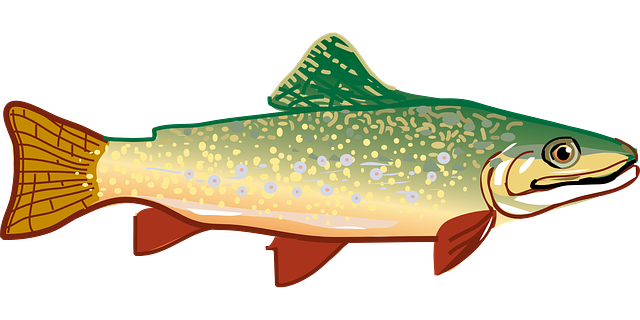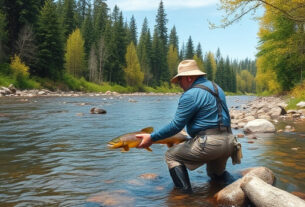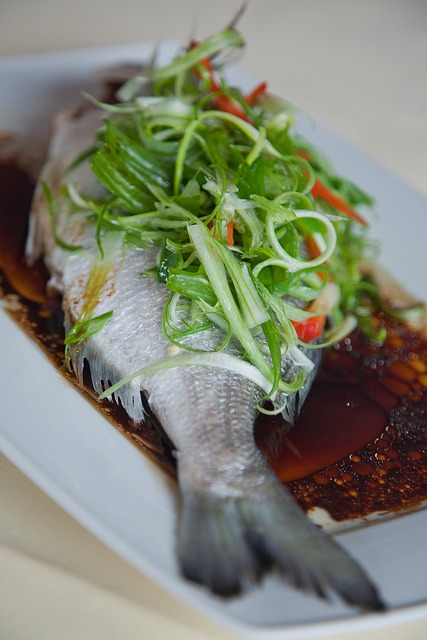Trout fishing throughout the year requires a strategic approach that aligns with the trout's seasonal behaviors. In spring, as temperatures rise, trout become active, particularly during insect hatches, making this an optimal time for river trout fishing using flies or lures that mimic these emerging insects. As summer heats up, trout move to cooler, faster-flowing river sections. Successful anglers then focus on early morning and late evening fishing to target these trout before they retreat to deeper waters. Lakes and reservoirs remain consistent in temperature, offering year-round trout fishing opportunities. Autumn sees trout preparing for spawning, becoming more aggressive feeders. This is a prime time for river trout fishing with larger lures or flies. Adaptability is key as changing foliage can affect water conditions, influencing the trout's feeding patterns. By implementing seasonal-specific trout fishing tips, from early spring insect hatches to autumn's aggressive feeders and the consistent cooling of lakes year-round, anglers can master river trout fishing and increase their catch effectively. Monitoring local weather and water conditions is essential for adjusting techniques and improving the chances of a successful trout fishing experience all year long.
When the cooler temperatures set in and the leaves begin to change, avid anglers turn their attention to the art of river trout fishing. This article serves as a comprehensive guide for those seeking trout fishing tips to enhance their angling skills throughout the seasons. From early spring’s awakening to the autumnal chill that spurs trout activity, we’ll explore the optimal times of year for catching more trout. Additionally, we’ll delve into how to adapt your techniques in different seasonal conditions, ensuring your next river trout fishing excursion is both productive and enjoyable. Join us as we navigate the rivers and streams, revealing the secrets behind successful trout angling all year round.
- Timing Your Trout Fishing Trips: A Seasonal Guide to Catching More Trout
- Strategic River Trout Fishing: Adapting Your Techniques Throughout the Year
Timing Your Trout Fishing Trips: A Seasonal Guide to Catching More Trout

When planning your trout fishing trips, understanding the seasonal patterns and behaviors of trout is key to increasing your chances of a successful catch. Early spring offers ideal conditions for river trout fishing as water temperatures begin to rise from their winter dormancy. This period, often coinciding with the hatching of insects, provides an abundant food source for trout, stimulating their appetite after the cold months. To capitalize on this, anglers should focus on presenting their flies or lures in a manner that imitates these emerging insects. As the water warms, trout become more active and can be found in faster, cooler water sections of rivers where oxygen levels are higher.
As summer progresses, trout fishing tips suggest targeting early mornings and late evenings to avoid the warmth of midday when trout tend to retreat to deeper, cooler pools. The peak of summer is still a good time for catching trout in lakes and reservoirs where the water remains cooler. For those who prefer river trout fishing, the transition into autumn brings about another prime opportunity. Cooling water temperatures trigger spawning behavior, and the trout’s metabolism increases, making them more aggressive feeders. This is the time to utilize larger, more attractive lures or flies. The fall months also bring about the changing of foliage, which can affect water temperature and light penetration, influencing feeding patterns. By being attuned to these seasonal changes and adapting your approach accordingly, you’ll be well on your way to a successful river trout fishing experience and more catches throughout the year.
Strategic River Trout Fishing: Adapting Your Techniques Throughout the Year

The art of trout fishing in rivers requires a strategic approach that adapts to the seasonal changes throughout the year. As temperatures fluctuate, trout behavior shifts, necessitating different techniques for successful catchings. In early spring, as water temperatures rise, trout become more active and can often be found in shallower, warmer waters. During this time, anglers should employ tactics such as dry fly fishing, which is one of the most enjoyable trout fishing tips for river anglers. This method involves using a light fly that floats on the surface of the water, imitating the mayflies, caddisflies, and other insects that are abundant during this season. The hatch brings trout to the surface as they feed, making it an ideal period for topwater action.
As summer progresses and water temperatures peak, trout seek cooler depths. This is when river trout fishing strategies must adapt once again. Long leaders and light tippets are crucial to make delicate presentations without spooking the fish. Nymphing becomes a preferred method, as it allows anglers to fish where the trout are hiding—in deeper pools and along structure like submerged branches and rocks. Indicator or Euro-nymphing techniques can be particularly effective, as they help detect subtle takes in the otherwise quiet undercurrents. As autumn arrives and water temperatures begin to drop, trout become more active again, preparing for the winter ahead. This is another prime time for catching trout, as they feed heavily before the cold sets in. Streamer fishing can be productive during this period, mimicking the bountiful fish meals that trout fatten up on before the colder months. Anglers should choose streamers that match the natural forage in the river, using sinking lines to get the fly down to where the trout are feeding. Throughout each season, staying attuned to the local weather patterns and water conditions, and being ready to adjust your tactics accordingly, will enhance your chances of a successful river trout fishing experience.
Anglers seeking to enhance their trout fishing experiences can benefit from the insights provided in this article. By understanding the seasonal patterns and adapting one’s techniques as outlined in “Timing Your Trout Fishing Trips: A Seasonal Guide to Catching More Trout” and “Strategic River Trout Fishing: Adapting Your Techniques Throughout the Year,” even novice fishers can improve their chances of a successful catch. Whether you’re planning your outings or refining your approach on the river, these trout fishing tips are invaluable for anyone eager to explore the rewarding world of river trout fishing and catching trout year-round. With careful planning and strategic adjustments, the next time you cast your line, you might just reel in a trophy trout.



